| Srl | Item |
| 1 |
ID:
075990
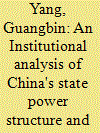

|
|
|
|
|
| Publication |
2006.
|
| Summary/Abstract |
With the alternative perspective of 'institutional paradigm' derived from the work of Douglass North and inspired by institutional economics, this paper explores the PRC's political economy from its formative period to the Reform Era. The author tries to show why State power, with overall control of the economic resources in the planned economy, was not total due to inefficient property rights, in which the State was not able to attain authority and legitimacy, and crises of national security occurred naturally. Economic reform has almost totally reconstructed economic and administrative institutions, but the party-centered State power remains unchanged. This paper shows why and how the State protects State-owned enterprises, which belong to the most influential group as well as being part of the established pillar of power. It also shows that the State protects and inspires non-State enterprises because they can produce maximum production and provide more resources for State power. Thus, the economic transition is full of paradoxes due to these internal conflicts with high institutional costs.
|
|
|
|
|
|
|
|
|
|
|
|
|
|
|
|
| 2 |
ID:
126056
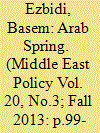

|
|
|
| 3 |
ID:
077132
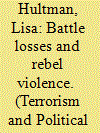

|
|
|
|
|
| Publication |
2007.
|
| Summary/Abstract |
In many armed conflicts, rebel groups deliberately target civilians. This article examines whether such violence is related to the performance of the rebels on the battlefield. It is proposed that rebel groups who are losing battles target civilians in order to impose extra costs on the government. When rebels attack civilians, the government may incur both political and military costs. Violence against civilians is thus used as an alternative conflict strategy aimed at pressuring the government into concessions. The argument is evaluated by using monthly data for rebel groups involved in armed conflict from January 2002 to December 2004.
|
|
|
|
|
|
|
|
|
|
|
|
|
|
|
|
| 4 |
ID:
158962


|
|
|
|
|
| Summary/Abstract |
In June 2016, the Colombian Government and the FARC insurgent movement signed a ceasefire agreement, which brings the two sides one step closer to putting an end to over five decades of war. Unfortunately, Latin America has a rich history of insurgent movements, particularly during the cold war era, some of which continue to operate today. Most of these movements disappeared due to military operations, though some did so via peace negotiations. This essay aims to discuss the various ends of Latin American insurgencies to answer whether, indeed, insurgents can be negotiated with.
|
|
|
|
|
|
|
|
|
|
|
|
|
|
|
|
| 5 |
ID:
126288
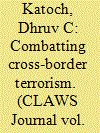

|
|
|
| 6 |
ID:
184841
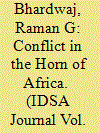

|
|
|
| 7 |
ID:
122229
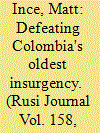

|
|
|
|
|
| Publication |
2013.
|
| Summary/Abstract |
The decision to enter into peace negotiations with the FARC represents the latest in a series of attempts by Colombia's Santos administration to prioritise political over military activities in seeking an end to the country's internal conflict. Yet despite favourable political conditions, a number of major challenges remain which could prevent a meaningful peace settlement from coming to fruition. Matt Ince argues that the single largest obstacle in this regard is the potential for the talks to cause fragmentation within the FARC, an outcome that could impede its leaders in negotiating a settlement viewed as legitimate by the entire organisation, while opening the door to the emergence of FARC splinter groups in the period ahead.
|
|
|
|
|
|
|
|
|
|
|
|
|
|
|
|
| 8 |
ID:
065121
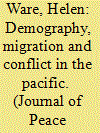

|
|
|
|
|
| Publication |
Jul-Aug 2005.
|
|
|
|
|
|
|
|
|
|
|
|
|
|
|
|
| 9 |
ID:
133753
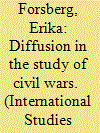

|
|
|
|
|
| Publication |
2014.
|
| Summary/Abstract |
This essay reviews diffusion as studied in large-N civil war research. In doing so, a number of pitfalls and lacunae are identified. First, the definition of diffusion as a process-whereby internal conflict in one location alters the probability of internal conflict erupting in another location at a later point in time-entails a number of difficulties for empirical modeling. Researching such a process involves an attempt to study a phenomenon that, in essence, is unobservable. It also creates difficulties in identifying relevant units of analysis, because the process involves at least two units. Second, diffusion is customarily identified based on correlations within a spatial and temporal proximity. Classifying it in this way risks simultaneously over- and underestimating cases of diffusion, which in turn generates uncertainty regarding the main determinants of diffusion. With these observations in mind, this essay ends with a word of caution for policymakers, with relevance extending beyond diffusion of civil war.
|
|
|
|
|
|
|
|
|
|
|
|
|
|
|
|
| 10 |
ID:
096268
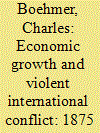

|
|
|
|
|
| Publication |
2010.
|
| Summary/Abstract |
Are states with growing economies more likely to become involved in violent interstate conflicts? This project examines whether economic growth increases international conflict using a global sample of states from 1875-1999. The theory argues that multi-year economic growth increases the resolve of state leaders to reciprocate and escalate militarized interstate conflicts, thus increasing the occurrence of fatalities or war. The results show that economic growth, but not growth of military expenditures, raises the risk of violent interstate conflicts. The results do not support the proposition that economic slowdowns result in violent interstate conflicts.
|
|
|
|
|
|
|
|
|
|
|
|
|
|
|
|
| 11 |
ID:
071017
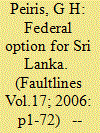

|
|
|
| 12 |
ID:
069420
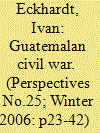

|
|
|
| 13 |
ID:
087455
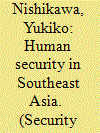

|
|
|
|
|
| Publication |
2009.
|
| Summary/Abstract |
This article explores the concept of human security and its relevance to the discourse and management of security in Southeast Asia. It examines whether the human security concept is applicable in the management of internal conflicts in that region, such as the conflict currently taking place in southern Thailand. The article argues that human security will have limited applicability in dealing with internal conflicts in Southeast Asia because of the huge gaps between what governments and other groups within Southeast Asian societies regard as threats. Nevertheless, the concept contributes to our understanding of the complex root causes of violence and illustrates links between human insecurity and conflict. The article concludes that the future usefulness of human security in efforts to manage internal conflict in Southeast Asia will depend on whether the analysis of specific situations incorporates a thorough understanding of the unique relationships between government and other groups, as manifested in the `ASEAN Way', within the localities in question.
|
|
|
|
|
|
|
|
|
|
|
|
|
|
|
|
| 14 |
ID:
075105
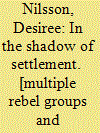

|
|
|
|
|
| Publication |
Uppsala, Department of Peace and Conflict Rsearch, 2006.
|
| Description |
viii, 145p.
|
| Series |
Report no. 73
|
| Standard Number |
9150618881
|
|
|
|
|
|
|
|
|
|
|
|
Copies: C:1/I:0,R:0,Q:0
Circulation
| Accession# | Call# | Current Location | Status | Policy | Location |
| 051952 | 355.0218/NIL 051952 | Main | On Shelf | General | |
|
|
|
|
| 15 |
ID:
156973
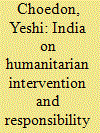

|
|
|
|
|
| Summary/Abstract |
India’s opposition to humanitarian intervention has been influenced by its colonial experience and its predisposition towards the principles of sovereignty and non-intervention. However, India did not adopt a strident opposition in the post-Cold War due to the changed power configuration. The article discusses how India adopted a cautious approach and yet used every opportunity to remind the international community the baleful effect of intervention in the internal affairs. After securing concession to a considerable extent on the ambitious Responsibility to Protect (R2P) and when most of the countries showed an inclination to accept humanitarian intervention in the form of ‘R2P’ at the UN summit in 2005, India grudgingly went along accepting it. India participated in the deliberation on the implementation of R2P and took its stand on various crises in which R2P was evoked. The experience of NATO’s Libya operation under R2P was regarded as substantiation of India’s apprehension of the misuse of the concept, and India reverted its position to the sceptical view of humanitarian intervention/R2P. By mere complaining about the mixing of peace enforcement with peacekeeping, when the United Nations deployed ‘intervention brigade’ for the protection of civilians, India lost the opportunity to take the initiative to propose a new mechanism to deal with the humanitarian crisis in atrocious internal conflicts.
|
|
|
|
|
|
|
|
|
|
|
|
|
|
|
|
| 16 |
ID:
167697
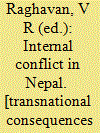

|
|
|
|
|
| Publication |
New Delhi, Vij Books India Pvt Ltd, 2011.
|
| Description |
xii, 272p.hbk
|
| Standard Number |
9789380177649
|
|
|
|
|
|
|
|
|
|
|
|
Copies: C:1/I:0,R:0,Q:0
Circulation
| Accession# | Call# | Current Location | Status | Policy | Location |
| 059704 | 954.96/RAG 059704 | Main | On Shelf | General | |
|
|
|
|
| 17 |
ID:
107039
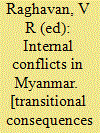

|
|
|
|
|
| Publication |
New Delhi, Vij Books, 2011.
|
| Description |
x, 264p.
|
| Standard Number |
9789380177632, hbk
|
|
|
|
|
|
|
|
|
|
|
|
Copies: C:1/I:0,R:0,Q:0
Circulation
| Accession# | Call# | Current Location | Status | Policy | Location |
| 056194 | 303.609591/RAG 056194 | Main | On Shelf | General | |
|
|
|
|
| 18 |
ID:
077688
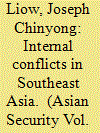

|
|
|
| 19 |
ID:
057024
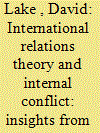

|
|
|
| 20 |
ID:
100763
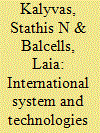

|
|
|
|
|
| Publication |
2010.
|
| Summary/Abstract |
Because they are chiefly domestic conflicts, civil wars have been studied primarily from a perspective stressing domestic factors. We ask, instead, whether (and how) the international system shapes civil wars; we find that it does shape the way in which they are fought-their "technology of rebellion." After disaggregating civil wars into irregular wars (or insurgencies), conventional wars, and symmetric nonconventional wars, we report a striking decline of irregular wars following the end of the Cold War, a remarkable transformation of internal conflict. Our analysis brings the international system back into the study of internal conflict. It specifies the connection between system polarity and the Cold War on the one hand and domestic warfare on the other hand. It also demonstrates that irregular war is not the paradigmatic mode of civil war as widely believed, but rather is closely associated with the structural characteristics of the Cold War.
|
|
|
|
|
|
|
|
|
|
|
|
|
|
|
|